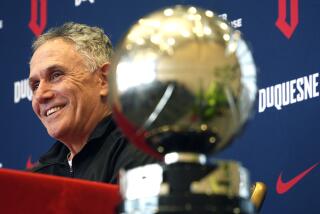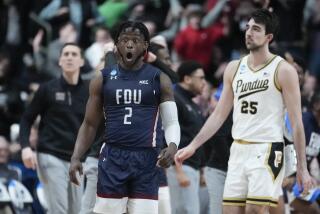Recalling When Duquesne Dukes Were Kings
- Share via
PITTSBURGH — It wasn’t all that long ago that Duquesne University’s tradition-laden Dukes were among college basketball’s blueblooded royalty, a rich motherlode of great coaches and players that made them one of the Top 10 winningest teams in the sport’s history.
While Duquesne was playing in 15 National Invitation Tournaments and four NCAAs and was producing the NBA’s first black player, Chuck Cooper, intracity rival Pitt was struggling to fill more than 1,000 seats in its deteriorating fieldhouse.
“It used to be that Duquesne was THE place to go. When you stayed in Pittsburgh to play basketball, you went to Duquesne because of the history ... ‘Chick’ Davies, Willie Somerset, Norm Nixon, Chuck Cooper, Sihugo Green,” said former Dukes’ star Garry Nelson.
But that was before the Big East Conference, coast-to-coast recruiting and, most importantly of all, TV exposure.
When Pitt jilted Duquesne and the Atlantic 10 Conference in 1982 to join the then-fledgling Big East, few could forsee how rapidly it would fuel the acceleration of Panthers’ basketball -- and the demise of Duquesne.
For example:
-- Pitt has spent millions to refurbish its now-cozy fieldhouse, where all 6,798 seats have been sold out for two seasons. The Panthers also sellout their two annual games at the 16,300-seat Civic Arena. Duquesne’s average attendance at the Arena has declined from 8,518 a game in 1970 to a mere 1,300 this season.
-- Since 1982, Pitt has had five winning teams, Duquesne one. Pitt has twice been ranked in the Top 10, has made three NCAA or NIT appearances and recruits successfully from California to Connecticut. Duquesne hasn’t played in a post-season tournament; eight of its 13 players are from the Pittsburgh area.
-- Seventeen of Pitt’s 27 games this season will be televised locally, 11 are being shown nationally. Duquesne is on regional TV twice.
-- Pitt basketball will make more than a million dollars this season. Duquesne not only will lose $500,000, it has suffered embarrassing blowout losses of 55 points to Arizona, 40 points to Temple and 27 points to Pitt in a game it trailed 17-0.
Duquesne is not the only city-based university suffering from a decline in its basketball fortunes; Detroit, Marquette, Xavier, Dayton, UCLA and Southern Cal are enduring similar slumps.
“It’s kind of sad to watch,” said Nelson, an attorney who played on consecutive 20-win Duquesne teams in the early 1970s. “I’m a little discouraged. ... It really hit me last summer when my 10-year-old, Erik, told me he wanted to go to Pitt’s camp instead of Duquesne’s.
“But how can you blame him? He reads the papers, watches the games on TV. He knows.”
John “Red” Manning, who coached the last great era of Dukes’ basketball from 1958 through 1974, can’t believe what has happened since he stepped down.
“I feel bad about it,” Manning said. “In 1970, when we were 21-4, I would not have thought Duquesne could be in this situation. It’s obvious they don’t have the talent other teams have.
“And the Big East is such a good league, gets so much exposure, by comparison Duquesne looks that much worse. It used to be only a handful of teams in the East wanted to have good teams. Not anymore. The local kids want to go where there’s a lot of action and good basketball, so they go to Pitt.”
Some say that Duquesne’s decline has resulted not only from Pitt’s ascension in the college basketball world, but a string of poor recruiting years, the inability of Coach Jim Satalin to attract out-of-town talent and indifference by the university administration.
“In this day and age, you have to expand your scope, you can’t do it all with local kids anymore,” Manning said. “The last president (the Rev. Donald Nesti, who resigned under fire last summer) changed the philosophy of athletics. He wanted the coach to also be the athletic director. ... That philosophy began the downfall, the slippage of the program.
“You need an AD to oversee the program ... there are just too many things going on -- recruiting, checking on rules violations, etc. -- for the coach to do it all. You need that watchdog, if only to keep people motivated.”
Since Satalin took over in 1982, Duquesne is 69-100, has had only one winning team and endured an image-damaging 1984 scandal in which four players -- including EmmettSellers, the Dukes’ top scorer this decade -- were charged with rape.
All four were cleared of charges, but two were expelled from school despite Satalin’s angry protest. Sellers, after returning from a nearly two-year layoff resulting from the case, wasn’t the player he had been before.
The scars from the case haven’t healed.
Duquesne sent 10 players to the NBA or the ABA from 1966 through 1974 but has produced none since. The night after Pitt and Syracuse played in front of the largest basketball crowd in city history, 16,798, Duquesne and Rutgers drew a sparse 843 to the Civic Arena on Feb. 11.
“I can’t wait for next year,” said Satalin, pointing to the completion of Duquesne’s $10.1 million, 6,300-seat on-campus Palumbo Center arena. “It can’t come too soon.
“It’s going to be great to have a home-court advantage for a change. There’s no advantage in a cold building where there’s no noise when you’re warming up, no noise even when you’re playing.”
But there’s been plenty of noise from disgruntled alumni unhappy with the waning of one of the East’s traditional powers.
“I’ve indicated my displeasure with the direction of the program,” said Mossie Murphy, a political consultant and Duquesne’s most visible basketball booster.
It was Murphy who paid sophomore center Pete Freeman the $1,200 in summer job wages last year that an in-house investigation determined he didn’t legitimately earn. Freeman was subsequently suspended for seven games by the NCAA.
Murphy claims he hired Freeman at Satalin’s request; Satalin has asked his players not to associate with Murphy, a man so closely tied to Duquesne’s program that he has been in the wedding parties of 27 former Dukes players.
‘When you’re losing like Duquesne is, everybody’s pointing fingers, everybody’s looking for somebody else’s scalp,” said Mike Barr, a Duquesne captain in the early 1970s.
“They haven’t gotten the blue-chip players or even the kind of players we had, those guys who weren’t necessarily great players but fit right into their roles.”
“They’ve got to improve their recruiting,” said Bill Zopf, a Duquesne grad who played briefly for the Milwaukee Bucks. “Maybe the fact Temple has a real nice program will help the other teams in the league recruit. And they’ve got to play a better schedule.
“It’s OK to play Iona and Bucknell, but you’d better beat them.”
“I used to brag about going to Duquesne, but I can’t now,” Barr said. “My brother, Jeff, struts around because he played football at Pitt, but they were terrible when he was there. It would be nice if I could do that
More to Read
Go beyond the scoreboard
Get the latest on L.A.'s teams in the daily Sports Report newsletter.
You may occasionally receive promotional content from the Los Angeles Times.










